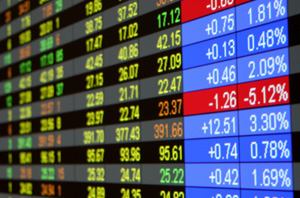Silver: From $30/oz. to over $500 by 2020. In under a minute, I can tell you why that price must happen, and likely when. It seems to me that the public will one day wake up and start buying silver to protect from inflation. Thus, long before, say 10-20% of people buy silver, at least 1% of the American public will buy silver. We can calculate what might happen to the silver price when that happens.
The amount of money in US Banks is about $18 trillion. 1% of that is $180 billion.
Very little silver is left; it's mostly all been consumed, so most of what is available to buy is the annual new mine supply which is 700 million ounces.
$180 billion is $180,000 million. Divide that by 700 million, and we get an implied price of $257 per ounce. Do the math yourself. I'll wait.
But that price would mean that there is no newly mined silver left over for any industrial use, and that nobody else outside of the USA could buy any of the world's newly mined silver. Clearly that can't happen; those two groups would continue to buy silver, competing to buy, and driving up the price even more.
Thus, silver is very likely to be about $500/oz., by about the time that 1% of the American public wakes up and starts to buy silver. That will be the very beginning of the bull market in silver, when measured by "popular demand" -- and at that price, silver would still be very unpopular.
Just remember these key facts, and don't let anyone, or even yourself, trick you out of this developing bull market in silver. Don't try to time the peaks, don't wait for dips, just buy and hold real silver, not any kind of paper silver promise.
What kind of annual gains will that be? Let's see, if silver goes from $30 to $500 in ten years, the compound interest rate calculator tells us that will be an average annual gain of 32.49%, which is about the same as what silver has done in the last seven years, from $4.15 to $30, which is a gain of about 32.66% per year, on average.
Oh, by the way, the 1980 high for silver was $50/oz. That was when M3, money in the banks, was about $1.8 trillion. Today, the monetary base has increased about ten times higher. Thus, the true inflation adjusted peak for silver would be $500/oz. That just further confirms this $500 estimate.
But there are many reasons why silver should surpass the former highs.
Key reasons to surpass the former 1980's peak:
1. Silver is more scarce due to 30 more years of industrial consumption.
2. Paper silver scams are more abundant.
3. Baby Boomers will be retiring, cashing out stocks and draining pension plans that have not yet invested into silver, causing other investments to vastly under perform silver, making silver ever more attractive.
4. More trend investors today will notice the silver bull market and continued gains in the silver price, and invest in it, and carry it to further highs.
5. The US government and political leaders are spending like never before, and the people, even the world over, lack the political will to control government spending which will ruin all currencies.
6. There are no "safe" currencies to run to, leaving gold and silver as the only alternatives; and gold and silver have been in bull markets in all major currencies for 10 years now.
I'm sure you can think of many other reasons, but that's enough for now.
So, the true skeptic may ask, "Yes, but this guy is a coin dealer, he's just pushing his product because he has plenty of silver he wants to dump. Besides, what kind of argument will he come up with to sell silver after it hits $500/oz.?"
Let me answer this two part question. Yes, I do have silver! I have it, because I believe that the price will go up a lot, thus, it makes perfect sense for me to carry it as inventory. I sell it, because few people are able to buy it in bulk like we can, so I use my own stash, and industry connections, to enable others to buy it.
But what will I say after silver hits $500/oz., or nears that price?
I'll say, "Obviously this bull market in silver is just getting started. Only 1% of American public money is buying silver per year. Just wait until at least 10% of US money is buying silver in a year, the price will be well over $2500 to $5000 per oz. for silver."
But I would never make that argument now. Too few people would believe me, and they would think I'm some kind of kook. And people never do business with kooks.
And what will I say when silver nears $2000/oz.?
I'll say, "Everyone knows it only costs 4 cents to print up a $100 bill, and everything returns to its intrinsic value. But used paper, particularly smelly paper, is worth even less, which is useful only for things like lining the bottom of the cages of birds, or burning in the fireplace. Thus, the price for silver will soon only be quoted in terms of gold, and certainly not quoted in terms of any kind of paper money at all." But again, I'd never say that today, everyone would think I'm crazy.
Oops. Too late for me. But it's not too late for you to buy some silver!
=====
I strongly advise you to take possession of real gold and silver, at anywhere near today's prices, while you still can. The fundamentals indicate rising prices for decades to come, and a major price spike can happen at any time.
Source: http://news.silverseek.com





